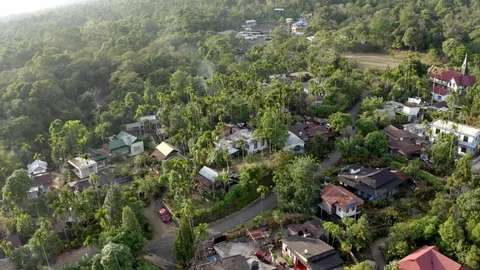Guwahati, Nov 4: Mawlynnong in East Khasi Hills is no more just the “Asia’s Cleanest Village”, the term coined a few years ago after unique cleanliness habits of the village community got noticed by travellers coming from far and wide.
According to a new academic study, eco-tourism in Mawlynnong has entered a new chapter — one defined by youth-led travel, local entrepreneurship, and growing challenges of balancing fame with sustainability.
Published in the SSR Journal of Economics, Business and Management (Special Issue, October 2025), the study — “A Study on India’s Top Emerging Eco-Tourism Destination: The Mawlynnong Village of Meghalaya” — offers a rare empirical look at how the village’s eco-tourism model is evolving. Conducted by Dr. Prabahan Puzari of Assam Royal Global University and Trianga Deka of Assam Don Bosco University, the research combines surveys from tourists, guides, and residents to capture the pulse of Meghalaya’s most visited village.
A New Generation of Travelers
The study identifies a major demographic shift: most tourists visiting Mawlynnong today are between 18 and 25 years old, many of them students or young professionals drawn by social media buzz and the promise of authentic experiences.
“Mawlynnong’s popularity among young travelers shows how eco-tourism is being redefined through digital culture,” the researchers note. Affordable stays, easy road access from Shillong, and its photogenic landscapes have made the village a Gen Z favorite.
Most visitors rated their experience as “satisfied” or “very satisfied,” citing cleanliness and hospitality as key highlights. The study points out that repeat visits and word-of-mouth loyalty are now emerging trends, a sign that Mawlynnong’s appeal has matured beyond curiosity tourism.
The Power of a Participating Community
Beneath Mawlynnong’s serene beauty lies a deeply participatory system. The research finds that the village’s cleanliness culture is not just a display for tourists — it’s a community ritual.
From children sweeping courtyards to elders monitoring waste segregation with bamboo bins, every resident plays a role. “This sense of collective responsibility transcends generations,” the paper observes.
Nearly 60 percent of households earn from tourism-linked livelihoods — homestays, handicrafts, guiding, and small eateries — while others continue farming. This blend of tourism and agriculture has created a rare equilibrium between conservation and livelihood.
Cleanliness as an Economic Advantage
Cleanliness, once a moral ethic, has now become Mawlynnong’s strongest economic asset.
Visitors overwhelmingly rated the village “Excellent” for hygiene — confirming that its reputation as “Asia’s Cleanest Village” continues to drive both visibility and revenue.
According to the researchers, this environmental branding gives Mawlynnong a competitive edge in India’s eco-tourism landscape, where sustainability increasingly influences travel choices.
Infrastructure Gaps and Culinary Potential
However, the study also cautions against complacency.
While the majority rated accommodation as “Good” or “Very Good,” some noted inconsistent hospitality standards and transportation issues caused by poor connectivity from Shillong and Guwahati.
Equally revealing is the finding that many tourists wanted more authentic Khasi cuisine.
“There’s scope to partner with local households to provide traditional meals,” the authors suggest, seeing food as a new avenue for cultural immersion. Introducing vegetarian and vegan-friendly Khasi options could deepen visitor engagement while supporting local producers.
Warning Signs of Over-Tourism
With Meghalaya welcoming 1.6 million visitors in 2024 and expected to cross 2 million in 2025, the paper raises the first academic warning about over-tourism in Mawlynnong.
During peak season, tourist inflow can swell the village population by nearly 50 percent, straining local infrastructure and peace.
The authors recommend visitor caps, seasonal scheduling, and improved road planning to prevent ecological and cultural degradation.
A Blueprint for Rural Sustainability
Despite these pressures, the study positions Mawlynnong as a replicable model for rural eco-tourism in India — where environmental ethics, local governance, and youth participation converge.
It urges policymakers to invest in capacity building for local hosts, standardized service benchmarks, and digital marketing campaigns to sustain the momentum.
“Economically, Mawlynnong has transformed through tourism while retaining its agricultural roots,” the paper concludes. “It stands today not just as a clean village, but as a living example of how environmental ethics, community resilience, and cultural pride can coexist.”
The Road Ahead
The next challenge, researchers say, is ensuring that development keeps pace with demand — and that the cleanest village in Asia remains one of its most sustainable too.




